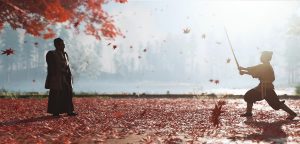A game produced in the West showcasing one of the most intricate Asian cultures? Of course, most of it will be exaggerated or extra-dramatized. However, most of what we believe about Samurais is also conveyed to us through the Western portrayal of it. Therefore, it doesn’t matter whether what is shown in the game is 100% authentic or not.
Key Takeaways
- Ghost of Tsushima may not be fully authentic to Samurai culture, but it offers a captivating and unmatched Samurai experience.
- Revolving around the concept of honor among samurais and the moral dilemma of going against their code of conduct, the whole storyline is comprehensively designed to give players an immersive experience.
- While its duel mechanics are impressive on their own, the whole build-up around these battles with dramatic atmosphere, dark aesthetics, storms, etc. makes it even more exciting.
- The game also gives respect to the samurai culture in subtle ways. For example, even with different difficulty levels, the lethality of katanas remains the same.
What matters is whether the game has something interesting to offer the players. In this regard, Ghost of Tsushima excels quite well, and I can confidently say that its Samurai experience is unmatched.
Previously, it was only available on PlayStation. Fortunately, PC fans also got access to this masterpiece by Sucker Punch Productions just last month and it has already amassed a 9/10 rating on Steam with over 17,000 reviews. Let’s talk about this masterpiece in detail:
Honor And The Samurai Code
I will start with the game’s central theme, i.e., Honor. I believe it is the main highlight of the storyline. Starting the game, you play as Jin Sakai, a samurai who faces the impossible task of defending Tsushima from Mongol invaders.
The game does the perfect job of incorporating myths related to samurais. For example, honor, bravery, and loyalty. The game starts pretty well with you sticking to these codes of conduct.
However, this code is tested as the Mongol invasion forces Jin to adopt the tactics of the Ghost (I will talk about it later in the article), creating a moral dilemma. By the way, this internal conflict is central to the story and also shapes Jin’s transformation.

How is it a dilemma? Well, it’s because the Ghost tactics are considered dishonorable by samurai standards. You will also see this duality in your gameplay, where you will be able to choose to confront enemies ‘honorably’ and by ‘dishonor’.
Similarly, the game will rub the consequences of your choices on your face in various ways. You will know what I’m talking about when you have a conversation with Jin’s uncle, Lord Shimura, the epitome of traditional samurai values. These in-game relationships are so strong that they take the immersion to the next level.
The Way Of The Ghost
Jin’s transition from a traditional samurai to the Ghost starts the tension between maintaining honor and achieving desired results. Stealth becomes an important part of gameplay at this stage of the game. Jin will adopt every nasty tactic despised by samurais to overcome his enemies.
This involves sneaking through enemy camps, silently eliminating enemies, using fear tactics and tools like kunai, smoke bombs, and wind chimes, etc.
The game stays true to the term ‘ghost’ as you will be able to use the environment to your advantage, hiding in tall grass or scaling rooftops for silent assassinations. As I said above, this transformation comes at a price.
For example, in one of the missions, Jin used poison to massacre a group of Mongols, which horrified his uncle, Lord Shimura. This episode upsets their relationship, and the rift only increases throughout the story, leading to his murder by your hands in the 3rd act.
Environment And Duel Mechanics
The game’s environment plays an important role in setting the tone and the overall fighting experience. While it isn’t historically authentic, it sure creates an exciting experience for players. The attention to detail in the surroundings, combined with the realistic sound design, makes every fight feel like a scene from a classic samurai film. Well, that was also the intention of the developers as Ian Jun Wei Chiew, Lead Concept Artist at Sucker Punch Productions, explained in a blog.
The duel mechanics are awesome but I think animations can be improved. Like I think it would be awesome if we could target a specific body part of the opponent. However, Nate Fox, the game’s Creative Director, answers this by saying that the duel mechanics are designed to finish enemies quickly and maintain a challenging environment.

Nevertheless, I love its duel mechanics. What made me fall for it was the fight against Ryuzo, Jin’s childhood friend-turned-rival. This duel takes place on a cliffside overlooking the sea, with a storm raging in the background. Such a dramatic set-up!
Another good thing about its combat is that you can select between three available difficulty settings. Unlike other games’ difficulty levels where enemies’ health bars also increase with increased difficulty, Ghost of Tsushima gives due respect to katana by maintaining its lethality throughout these levels.
I recommend completing the game once with easy mode and while doing so, roam the island freely and enjoy the beauty of it. You can replay it again with higher difficulty levels. Now that it is available on PC, I seriously recommend you give it a try.
Good job! Please give your positive feedback 😏
How could we improve this post? Please Help us. 💡
I have been into gaming since my childhood and have been writing about it for three years now. Pursuing a bachelor’s degree in Communication Studies side-by-side, I spend lots of time reading books, learning new skills, playing chess, working out, and engaging in Reddit threads related to gaming.



